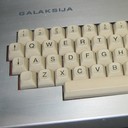29C3 - Version 1.9
| Speakers | |
|---|---|
|
|
Tomaž Šolc |
| Schedule | |
|---|---|
| Day | Day 4 - 2012-12-30 |
| Room | Saal 6 |
| Start time | 14:00 |
| Duration | 01:00 |
| Info | |
| ID | 5178 |
| Event type | Lecture |
| Language used for presentation | English |
| Feedback | |
|---|---|
|
Did you attend this event? Give Feedback |
The ultimate Galaksija talk
Everything about a Yugoslavian microcomputer halfway between a TRS-80 and a ZX 80

Galaksija was to be in Yugoslavia what Commodore and Sinclair were in the west. Whether it succeeded or not, its deceptively simple design can still teach us a lot of interesting tricks on how to make a usable computer and operating system with as few transistors and bits as possible.
Galaksija was a Yugoslavian home microcomputer popular in the local DIY community throughout the 1980s. It was meant as an alternative to illegally bought contemporary Sinclair and Commodore computers. It is a fascinating product of the time of severely limited availability of electronic components and a widespread disregard for copyright.
This situation led to unique design decisions on both the hardware and software side. Galaksija can display better graphics than Sinclair ZX 80 with only a small number of general-purpose digital logic integrated circuits. Since it included no specialized chips it was easy to build at home. Being constrained to a relatively small EPROM, Galaksija's built-in BASIC interpreter was based on a stripped-down and hand-optimised Tandy TRS-80 ROM. It relies on undocumented Z80 features, "racing the beam", executing error messages and floating point constants as code and similar tricks. By not including an auto-run feature the authors also made sure that Galaksija programs were hard to copy-protect, encouraging sharing and an early open-source like approach to developing software.
This is a talk inspired by the Atari 2600 and Commodore 64 ultimate talks from the previous Congresses and the 30th anniversary of Galaksija's design. In 45 minutes it will include a brief introduction about the history of Galaksija and home microcomputers in Yugoslavia at the time. It will then cover all aspects of Galaksija's hardware design, built-in ROM routines and original software that has been preserved to this day. It will end with coverage of what tools exist today to develop software for Galaksija, either for running in one of the software emulators, on hardware replicas or the real thing.
I'm an electronic engineer and this talk is based on my university diploma thesis about reverse engineering Galaksija's hardware and software design and tracing back its origins. I have designed and made a working replica using modern CMOS logic that preserves Galaksija's features, look and DIY-nature as much as possible. CMOS Galaksija has been presented in a number of retro-computing events and talks. I am also the author of a number of Galaksija demos and a Free software Galaksija developer's kit.
